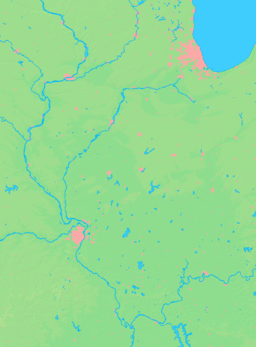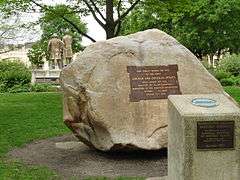Ottawa, Illinois
| Ottawa, Illinois | |
| City | |
 Downtown Ottawa, Illinois in May 2008 | |
| Nickname: Radium City, The Friendly City, The Town of Two Rivers, The City On Sand, The Town of Stovepipe hats | |
| Country | United States |
|---|---|
| State | Illinois |
| County | LaSalle |
| Townships | Ottawa, South Ottawa, Dayton, Rutland, Wallace |
| Elevation | 482 ft (147 m) |
| Coordinates | 41°21′04″N 88°50′16″W / 41.35111°N 88.83778°WCoordinates: 41°21′04″N 88°50′16″W / 41.35111°N 88.83778°W |
| Area | 12.80 sq mi (33 km2) |
| - land | 12.00 sq mi (31 km2) |
| - water | 0.80 sq mi (2 km2) |
| Population | 18,562 (2013) |
| Density | 1,547/sq mi (597/km2) |
| Incorporated | 1853 |
| Government type | Mayor-council |
| Mayor | Robert M. Eschbach |
| Timezone | CST (UTC-6) |
| - summer (DST) | CDT (UTC-5) |
| ZIP code | 61350 |
| Area codes | 815, 779 |
  Location of Ottawa within Illinois | |
| Wikimedia Commons: Ottawa, Illinois | |
| Website: www.cityofottawa.org | |
| [1] | |
Ottawa is a city located at the confluence of the navigable Illinois River and Fox River in LaSalle County, Illinois, United States. The Illinois River is a conduit for river barges and connects Lake Michigan at Chicago, to the Mississippi River, and North America's 25,000 mile river system. The population estimate was 18,562 as of 2013.[2] It is the county seat of LaSalle County and it is part of the Ottawa-Peru, IL Micropolitan Statistical Area.
History

Ottawa was the site of the first of the Lincoln-Douglas debates of 1858. During the Ottawa debate Stephen A. Douglas, leader of the Democratic Party, openly accused Abraham Lincoln of forming a secret bipartisan group of Congressmen to bring about the abolition of slavery.[3]
The John Hossack House was a "station" on the Underground Railroad, and Ottawa was a major stop because of its rail, road, and river transportation.[4] Citizens in the city were active within the abolitionist movement. Ottawa was the site of a famous 1859 extrication of a runaway slave named Jim Gray from a courthouse by prominent civic leaders of the time. Three of the civic leaders, John Hossack, Dr. Joseph Stout and James Stout, later stood trial in Chicago for violating the Fugitive Slave Law of 1850.[5]
Ottawa was also important in the development of the Illinois and Michigan Canal, which terminates in LaSalle, Illinois, 12 miles to the west.
On February 8, 1910, William Dickson Boyce, then a resident of Ottawa, incorporated the Boy Scouts of America. Five years later, also in Ottawa, Boyce incorporated the Lone Scouts of America. Boyce is buried in Ottawa Avenue Cemetery. The Ottawa Scouting Museum, on Canal Street, opened to the public on December 6, 1997. The museum features the history of Boy Scouting, Girl Scouting and Camp Fire.[6]
In 1922, the Radium Dial Company (RDC) moved from Peru, Illinois to a former high school building in Ottawa. The company employed hundreds of young women who painted watch dials using a paint called "Luna" for watch maker Westclox. RDC went out of business in 1936, two years after the company's president, Joseph Kelly Sr., left to start a competing company, Luminous Processes Inc., a few blocks away.
Geography
According to the 2010 census, Ottawa has a total area of 12.799 square miles (33.15 km2), of which 12 square miles (31.08 km2) (or 93.76%) is land and 0.799 square miles (2.07 km2) (or 6.24%) is water.[7]
Industry
Because of numerous silica sand deposits (Ottawa sand was on board the ill-fated Columbia space shuttle for experimental purposes) Ottawa has been a major sand and glass center for more than 100 years. Transportation of the sand is facilitated by the navigable Illinois river and the Illinois Railway Ottawa Line. One of its largest employers is Pilkington Glass works, a successor to LOF (Libbey Owens Ford). Formerly concentrated in automotive glass, the plant now manufactures specialty glass and underwent a $50 million renovation in 2006. Ottawa sand continues to be extracted from several quarries in the area, and is recognized in glass-making and abrasives for its uniform granularity and characteristics.
Sabic recently purchased GE Plastics, a successor to Borg Warner automotive glass manufacture, operates a large plastics facility in Ottawa, and is a major employer.
Ottawa sand is a standard testing medium in geotechnical engineering (laboratory demonstrations and research in to new technologies).
Demographics
| Historical population | |||
|---|---|---|---|
| Census | Pop. | %± | |
| 1870 | 7,736 | — | |
| 1880 | 7,834 | 1.3% | |
| 1890 | 9,985 | 27.5% | |
| 1900 | 10,588 | 6.0% | |
| 1910 | 9,535 | −9.9% | |
| 1920 | 10,816 | 13.4% | |
| 1930 | 15,094 | 39.6% | |
| 1940 | 16,005 | 6.0% | |
| 1950 | 16,957 | 5.9% | |
| 1960 | 19,408 | 14.5% | |
| 1970 | 18,716 | −3.6% | |
| 1980 | 18,166 | −2.9% | |
| 1990 | 17,451 | −3.9% | |
| 2000 | 18,307 | 4.9% | |
| 2010 | 18,768 | 2.5% | |
| Est. 2015 | 18,342 | [8] | −2.3% |
As of the 2010 Census,[10] there were 18,768 people residing in the city with a population density of 1,563.9 people per square mile (604/km²). The age distribution consisted of 23.3% persons under the age of 18 and 16.6% aged 65 or over. Females made up 51.2% of the population. The racial makeup of the city was 93.4% White, 2.0% African American, 0.3% Native American, 0.9% Asian, 1.5% from two or more races, and 3.4% Hispanic or Latino of any race.
There were 7,841 households occupying 8,569 housing units. The average household size was 2.39 persons. Per capita income was $25,414 and the median household income was $47,480. The median value of owner-occupied housing units was $132,900.
Tourism
Ottawa has many historic homes and registered historic landmarks. Recent additions to Ottawa have included renovations to its historic mansion, Reddick Mansion, and artistic murals throughout the central business district. Ottawa is known as the scenic gateway to Starved Rock State Park, the most popular state park in Illinois, with some 2 million visitors per year. The Fox River, which flows through communities like Elgin and Aurora, empties into the Illinois in downtown Ottawa. Ottawa is also home to one of the largest skydiving operations in the country, Skydive Chicago.[11][12]
Ottawa Scouting Museum honors Ottawa resident William D. Boyce, the founder of the Boy Scouts of America.
Once an old Norwegian Lutheran Church, Norsk Museum is located 9 miles northeast of Ottawa, on Highway 71. The museum is dedicated to the Scandinavian settlers who founded the area around neighboring Norway, Illinois, in the 1800s.[13]
Jacob C Zeller founded the Zeller Inn and Court Place Tavern in 1871, at 615 Columbus Street. The original Zeller Inn was demolished in 1982. The Zeller Inn tavern, originally known as the Court Place, still remains, now called Zeller Inn. The courtyard patio area on Columbus street is where the original Zeller Inn stood. The tavern contains the original mahogany bar built by the Sanders Bros in Ottawa, marble counters, tiled floors and walls, stained glass door and light fixtures. It also was known for its Gilded Age brilliance — tiled mahogany bar, carved gargoyles, pressed-tin ceiling and solid oak backbar. The mirror on the bar is the same since its establishment in 1871, which was brought over from the 1800s era European Worlds Fair. Zeller's initials, JCZ, are still visible in a tiled mosaic on the side of the bar and in the glass light domes that hang from the ceiling. This is one of the oldest taverns in Illinois, with original features which remain intact and displays the architectural details prominent in the late 1800s.
Media
- Ottawa was served by two local newspapers. The older of the two, The Times, formed in 2005 when the Streator Times-Press merged with The Daily Times, based in Ottawa. The second was a weekly newspaper called "Ottawa Delivered" (closed in 2012)[14]
- Ottawa is also served by the NewsTribune of La Salle, Illinois.[15]
Radium City Documentary
In 1986, documentary film maker Carole Langer made a film that covered the plight of the so-called "Radium Girls" who worked in the watch dial industry. The women, who had been told the paint was harmless, ingested deadly amounts of radium after being instructed to lick their paintbrushes to sharpen them; some even painted their fingernails with the glowing paint. Many of the women began to suffer from anemia, bone fractures and necrosis of the jaw, a condition now known as radium jaw. Many of these women died young.
The documentary interviews survivors from the industrial tragedy who relate their experiences of the poisoning and the bureaucratic nightmare they were forced to contend with in seeking compensation and justice. Radium City outlines the aftermath of these events with a focus on the social and political consequences as well as the medical ones.
According to the film, after the Radium Dial workers began to get sick, a lawsuit was brought against Radium Dial Company. With the looming lawsuit, it closed and then re-opened under the name Luminous Processes in another part of town. The workers, though more concerned, kept on working.
The film shows the dismantling of the High School where the Radium Dial Company was housed. The building materials were eventually turned into landfill. The U.S. Environmental Protection Agency began removing contaminated material in 1986.[16] The work continues.
After the plant closed and before it was dismantled many residents took items from the factory for their homes. This spread the contamination even further.
Areas still affected by radiation
Several areas of Ottawa are still radioactive. The United States Department of Health and Human Services released a study [17] outlining areas where contamination by radium-226 (Ra-226) as well as emissions of radon-222 (Rn-222) are at or above normal levels. These areas include homes, public areas, schools, and even a car sales lot that is housed directly over the old Radium Dial Company site.
It should be noted that the radium in Ottawa's water supply is not from Radium Dial and Luminous Processes. Rather, it's naturally occurring and found in water from deep wells all over northern Illinois.[18] A reverse osmosis water treatment plant removes the radium so the city's tap water complies with federal regulations.[19]
Notable people


See also

- Fisher-Nash-Griggs House
- John Hossack House
- Knuessl Building
- Marquette High School
- Andrew J. O'Conor III House
- Ottawa Avenue Cemetery
- Ottawa Township High School
- Starved Rock
- Jeremiah Strawn House
- Washington Park Historic District
- Ottawa Station (Rock Island Line)
References
- ↑ "Geographic Names Information System". United States Geological Survey. Retrieved 2008-01-31.
- ↑ "2013 Population Estimate". American FactFinder. US Census Bureau. Retrieved 12 December 2014.
- ↑ "First Debate with Stephen A. Douglas at Ottawa, Illinois". Lincoln Home National Historic Site. National Park Service. Retrieved 2008-11-01.
- ↑ "List of Sites for the Underground Railroad". Aboard the Underground Railroad. National Park Service. Retrieved 2008-11-01.
- ↑ "The Jim Gray Case". John Hossack website. Jay W. Preston. Retrieved 2008-11-01.
- ↑ "Ottawa Scouting Museum". Ottawa Scouting Museum website. Retrieved 2008-11-02.
- ↑ "G001 - Geographic Identifiers - 2010 Census Summary File 1". United States Census Bureau. Retrieved 2015-12-27.
- ↑ "Annual Estimates of the Resident Population for Incorporated Places: April 1, 2010 to July 1, 2015". Retrieved July 2, 2016.
- ↑ "Census of Population and Housing". Census.gov. Retrieved June 4, 2015.
- ↑ "Ottawa, IL QuickFacts". Ottawa, IL QuickFacts. US Census Bureau. Retrieved 15 January 2014.
- ↑ Starved Rock State Park (Illinois Department of Natural Resources)
- ↑ Reddick Mansion (The Reddick Mansion Association)
- ↑ 1834 settlement at Norway, Illinois (Illinois History)
- ↑ "About Us". The Times (Ottawa). Small Newspaper Group Inc. Retrieved 2011-05-04.
The Times, based in Ottawa, Illinois, is owned by the Small Newspaper Group Inc. In September 2005, The Daily Times, based in Ottawa, merged with its sister paper, The Times-Press, based in Streator. The paper is now called The Times.
- ↑ "About Us". NewsTribune. Retrieved 2011-05-04.
In 1946, Mr. & Mrs. Peter Miller purchased the Peru News-Herald and shortly after also purchased the La Salle Post-Tribune. In 1946 these papers were merged into the Daily News-Tribune. Peter Miller III joined the newspaper operation in 1982 and later changed the name of the publication to the NewsTribune.
- ↑ http://www.epa.gov/R5Super/npl/illinois/ILD980606750.htm
- ↑ http://www.atsdr.cdc.gov/HAC/pha/OttawaRadiationAreas/OttawaRadiationAreasPHA072506.pdf
- ↑ http://www.isws.illinois.edu/pubdoc/IEM/ISWSIEM2006-04.pdf
- ↑ http://www.cityofottawa.org/water-treatment-plant-history
External links
| Wikimedia Commons has media related to Ottawa, Illinois. |
- City of Ottawa, Illinois
- Reddick Public Library
- Ottawa Visitors Center, Ottawa, Illinois
- Mr. Lincoln and Freedom: the Lincoln-Douglas Debate in Ottawa, Illinois on August 21, 1858
- 1994 reenactment of Lincoln-Douglas Debate in Ottawa televised by C-SPAN (Debate preview and Debate review)